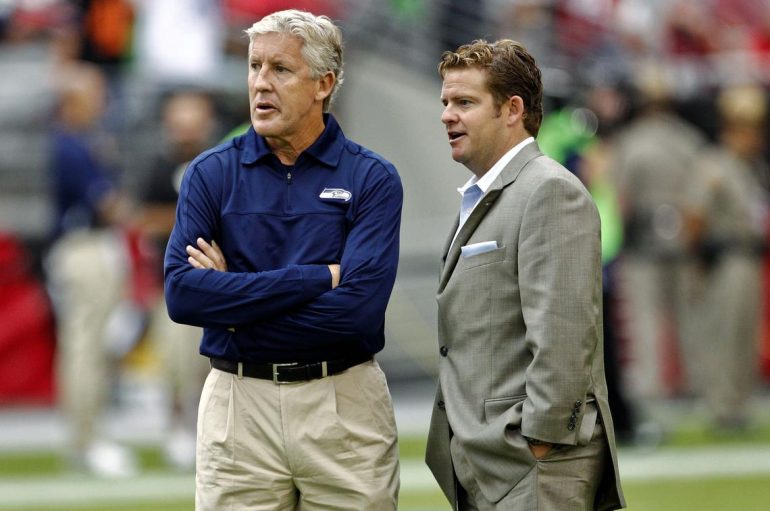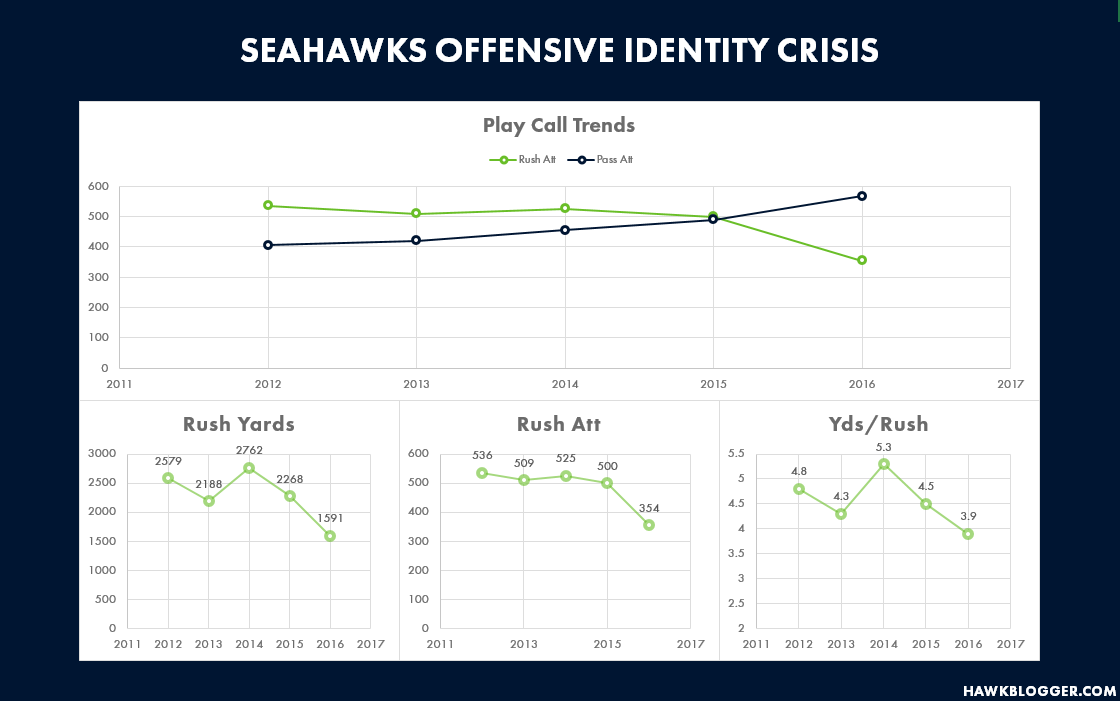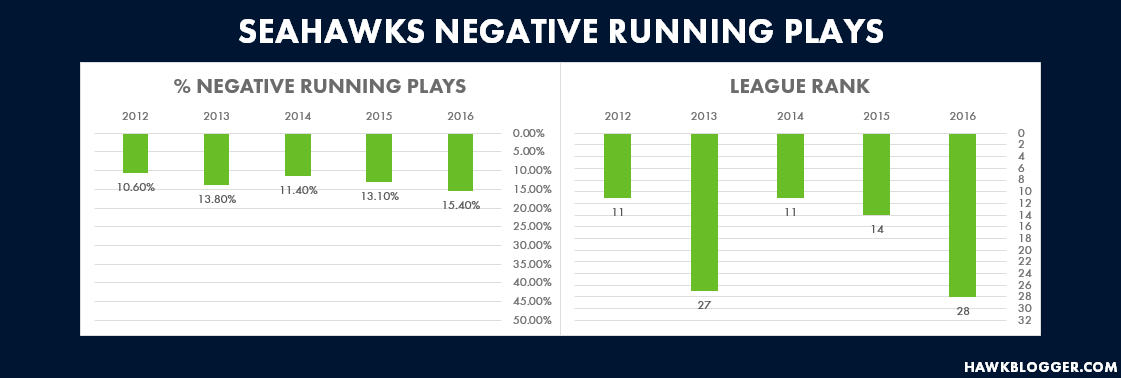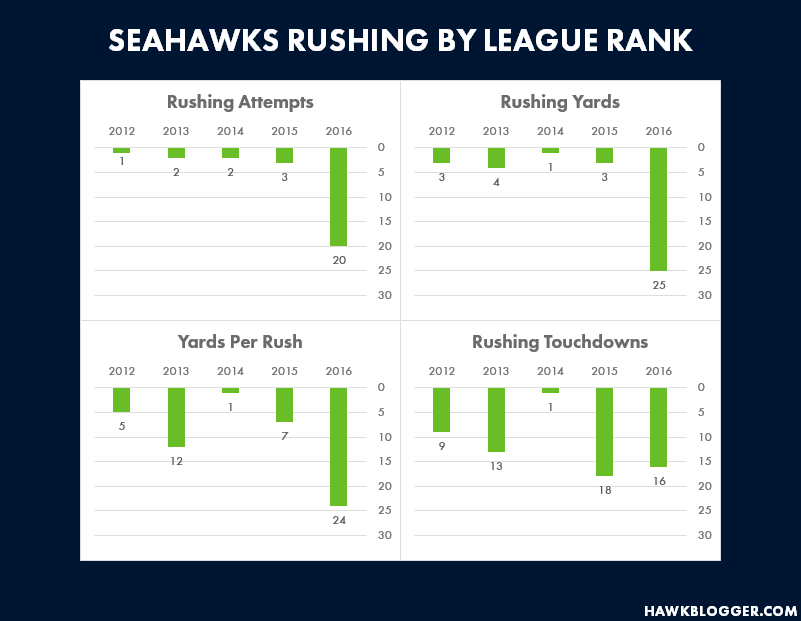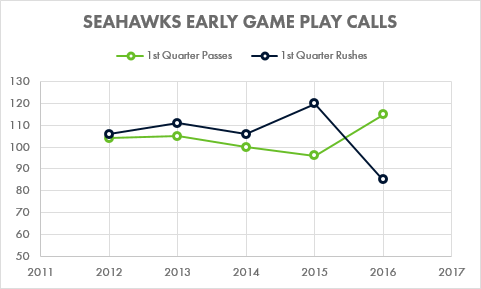Much has been written about the Seahawks that has nothing to do with the play on the field. Whatever the reality is in that locker room, there are more pressing football questions facing the Seahawks that must be addressed if this team is to lift another Lombardi Trophy. Pete Carroll brought a crystal clear football philosophy with him to Seattle. It helped create one of the most talented and tough teams in the NFL over the past six years. Between 2012 and 2014, the Seahawks averaged 12 wins per year and played in two Super Bowls. They have averaged 10 wins in the two years since, and have lost badly in the second round of the playoffs both times. There is evidence that the Seahawks have lost touch with the philosophy that helped them rise to the top. How they confront this identity crisis will have a far greater impact on their football fortunes than any soap opera brewing behind the scenes. In this series, we will explore different aspects of Carroll’s philosophy and assess whether the 2017 Seahawks are in position to recapture their dominant formula.
“If you don’t have a clear view of your philosophy, you will be floundering all over the place. If you win, it will be pure luck.” – Pete Carroll USC Coaching Clinic
Offensive Philosophy: Physical Run Game
Carroll’s new age approach to coaching belies his love of the physical side of the game. He wants to be the toughest team at all times, and his philosophy emphasizes the aspect of the game that define toughness in his eyes. That starts with a physical running game that will pound the rock against any defense on any down and at any time. He wants opponents to dread the battering ram coming their way before the game, and wilt under its relentlessness when the fourth quarter rolls around. Carroll has reiterated this consistently throughout his time in Seattle, but this may be his most complete explanation:
“It’s the most consistent, proven championship formula in the history of this game. When you tie it all together – and it’s not just that we want to run it, it’s about ‘we want to take care of the football’, ‘we want to own the football’, and that’s the biggest determining factor for winning and losing.
So, when you start tying it all together, a balanced offense gives you a better chance of taking care of those issues, better than just going to the throwing game. The throwing game is a great way to go, [but] it’s most reliant on a quarterback that’s got to be there for you…
The drastic example is, look at when Peyton left the Colts. That football team fell apart until they got their new quarterback, and then they go back. I don’t want to put our program in that situation ever. I want to always be ready to play with the guys that we have available, and give us a chance to keep winning and continue to win.
[It’s] the way we want to play. We want to be physical, we want to be tough, we want to attack you, we want to get after you, we want to make sure you know you’ve played a very hard football game; when you play our team, we’re going to beat the hell out of you if we can.
All that ties together with defense and special teams and a running game. You don’t get that feeling when you’re a throwing team. You can’t get that.
So, that’s why Marshawn is so important. When you put all these elements together, there is some thought here, I want to put together a football team that does a number of things really well, that there’s a number of ways we can beat you…
Those are just more factors, more ways to win football games, so that we maximize our chance to keep winning and stay on top. So, all that fits together. I don’t see that happening with a throwing game, I don’t see that happening unless you’ve got three quarterbacks in your back pocket that can all do it, because if you lose one guy, or he gets a hamstring or something, then where are you?
It’s not about winning just this game or this year, it’s about a long-range approach to winning over a long period of time.” Source: Pete Carroll Show on 710 ESPN
That well articulated philosophy is at odds with the way the offense has been trending, especially last year. What is less clear is whether those trends are indicative of a concerted effort to morph the Seahawks offensive identity to emphasize their franchise quarterback or an adaption to a faulty running game.
The stats tell a story
Most fans and media focus on the Seahawks ability, or lack thereof, to protect Russell Wilson when he drops back to pass. That is a legitimate issue, but the heartbeat of this offense has been based on an unending commitment to the run. This is a team that would regularly see extra defenders brought near the line of scrimmage to take away the run game, but would run the ball anyway. Marshawn Lynch played a key role not only because he was willing and uniquely capable of taking on the extra unblocked defenders, but because he knew the scheme so well that he almost always maximized the yards available. Take a look at how breakdowns in the running game reached critical levels last season:
Seattle was one of the least efficient running teams in the NFL last year. Their percentage of running plays that lost at least one yard was the highest it has been since Wilson entered the league, and was 28th in the league. You can see that the championship team in 2013 struggled with negative rushing plays as well. Many people forget that team spent most of the year with Paul McQuistan and Michael Bowie at left and right tackle, and also were without Max Unger at times. They also were up against an incredibly talented 49ers defense twice per year, as well a Rams and Cardinals defense that were very strong in their own right. That was the year, for example that Robert Quinn had 19.0 sacks for the Rams. Conversely, the Seahawks plays a 49ers defense last year that was one of the worst run defenses in history. It felt as though the coaching staff lost faith in their running game.
What is most concerning about those trends is the drop in attempts. The results varied from year-to-year, but the philosophy was consistent. Seattle was going to run the football over and over and over again. Before anyone starts with the, “teams who are ahead run the ball more” argument, consider that the Seahawks first quarter play-calling indicated the dedication to the run was missing from the first snap.
This lack of commitment to the running game happened early on last year. Wilson’s injury had a definite impact, but not just in the reduction of his rush attempts. The team appeared to have no answer for how to establish the run without the threat of the read option. They had become so reliant on that as a staple of their rush attack, that going back to a more classic rushing game was foreign. Thomas Rawls was reinjured in the second game, and that combined with a lack of confidence in Christine Michael to drive the coaches away from dialing up running plays.
One of the lessons to be learned is that Tom Cable’s confidence in the running back is at least as important as the performance in the offensive line. Michael, for example, was averaging close to 5.0 yards per carry early last year. His lack of physicality and discipline caused Cable and Darrell Bevell to shy away from him.
Without that dedication to the run, the weight of the offense fell to the passing game. Defenses had less of a need to dedicate an extra defender to stopping the run, and were more free to rush the passer. Seattle lost their balance on offense, and got a glimpse of what they look like as a pass-first squad.
One of the league’s most efficient passing attacks strained under the volume of more pass attempts and the lack of run game. Wilson has limited mobility due to his injury and was forced to throw more often from the pocket and be more decisive in reading the defense quickly to avoid the pass rush. He also lost one of his greatest weapons, the play-action pass, as there was little threat of the handoff. It became his least efficient season.
Trading great for not good enough
Seattle was a top five running team in terms of attempts and yards every year from 2012 to 2015. They lost grip on that last year and attempted to replace it with higher volume pocket passing game that was more in line with the general league trend. What did they get? A middling pass attack that failed to carry the team.
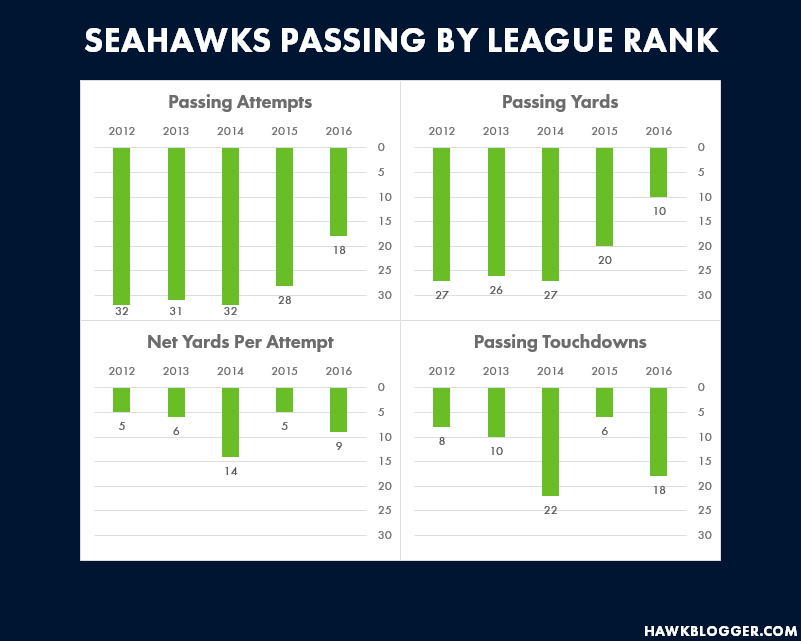
Those who watched Wilson operate at an MVP level during the second half of the 2015 season know he is capable of greatness through the air. What many still underestimate is his impact on the running game. Lynch retiring and poor offensive line play are convenient excuses. Wilson’s injury played a far larger role. Many analysts have wondered aloud whether Wilson will be able to carry the offense when he gets older and is unable to scramble as deftly as he does now. I have set those questions aside because Wilson has historically been quite effective throwing from the pocket. It is a misnomer that he only makes plays off-script. What last season highlighted, though, is that a loss of his ability to contribute in the running game could have a chilling effect on his passing proficiency and the offense overall.
The 22 points per game the Seahawks scored last year was the lowest since Carroll’s first year in Seattle when the team averaged just 19.4 points per game. It was a team effort. The coaching staff was not committed to adapting to the loss of Wilson’s legs and their favorite read-option package. They were too easily swayed away from their core philosophy and toward a pass-centric approach. The offensive line was young and mistake-prone. The running backs were young and injury-prone. Tyler Lockett was injured and less effective. Jermaine Kearse was healthy and less effective. Wilson was injured and not yet wily enough to outthink defenses.
Looking ahead to 2017
“We’re always looking for a guy that can manage the offense, really. We’ve always said, even way back with Heisman Trophy winners (at USC), we were never structuring the offense to be carried by one guy.” – Pete Carroll Tacoma News Tribune
All the issues that slowed down the Seahawks offense in 2016 are addressable as long as the coaching staff returns to the core philosophy. If there is any notion that the team should continue to trend toward more passing and less running, fans should have serious doubts. Wilson has yet to prove he can handle the sophistication of passing offenses like what Tom Brady, Peyton Manning, or Drew Brees have run. Bevell has yet to prove he knows how to put Wilson and the offense in a position to succeed when the run game is playing second fiddle.
Even during the record-setting second half of the 2015 season, the running game was terrific. What everyone forgets is the Seahawks ran the ball more in the second half of that season, not less. Wilson simply added ninja-like efficiency in situational passing on 3rd down and in the red zone to an already productive running game. That’s where this offense can shine. Efficient passing must be added to, not a replacement for, productive running.
In that kind of system, Wilson can be an MVP, the defense can shoulder less of a burden, and the offensive line will have to deal with fewer pass rushing situations. This is not my philosophy. It is Carroll’s, and he must recommit to it.
There are some promising signs in that regard. The team made signing a proven running back a top priority in free agency, despite having a stable of young backs already on the roster. Eddie Lacy is someone who can take on unblocked defenders and punish them. His issue has never been talent. It has been durability. He will not be asked to be the featured running back who takes 20+ carries per game. Thomas Rawls and C.J. Prosise are too talented to sit on the sidelines, and spelling Lacy should only help him stay healthy.
Speaking of health, Rawls and Prosise have had the benefit of a full NFL offseason program for the first time. Rawls was injured after his rookie year and spent all his time on rehab. Prosise just finished his rookie season. The Seahawks sports science team is among the best in the league. Having seen both players in person, it is clear that they are in peak physical condition. Prosise, in particular, has added some much-needed muscle.
Wilson caught a glimpse of what life would be like if he had to battle through injury or was in less than great shape. Word is he has put in tons of work this offseason to train and bring back his physical gifts. What I would love to hear at some point is that Wilson is being coached up on some of the finer points of the position instead of just physical training. That may be happening, but I have yet to hear about it. Carroll spoke about giving him a “master’s course” last year before learning about limits to how much coaches can interact with players during the offseason. That puts the onus on Wilson to reach out to Kurt Warner, Matt Hasselbeck, Peyton Manning, Warren Moon, or any other cerebral quarterback to help him reach his potential.
The offensive line remains a serious concern. Losing T.J. Lang in free agency was a bigger hit than the team will admit. There is a reason they went hard after him and offered him so much money. Having two Pro Bowl caliber players in Justin Britt and Lang paired together would have lifted the whole line, and allowed for productive pairings in the run game. The signing of Luke Joeckel should be met with healthy skepticism. Seattle sees player talent differently than the rest of the league. That has proven to be an advantage at some positions (e.g., cornerback, quarterback), but questionable at best at others like the offensive line.
We can say it would be hard for the line to be less experienced or less productive than they were a year ago. More than that is just wishful thinking. Training camp won’t prove much. Preseason, where last year’s line led the league in yards before contact for runners per ProFootballFocus, is misleading as well. We will not truly know if this line is going to allow the offense to run until the regular season begins.
The true key to the Seahawks regaining the offensive balance that has served them so well is for the coaching staff to show an unbending commitment to it. Without that, the Seahawks are doomed to be a knock-off instead of a slobberknocker.
Part two of this series will look at turnovers, another central tenet of Carroll’s philosophy.
